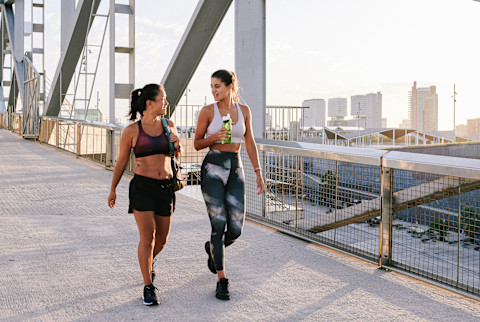From Zone 0 To VO2 Max: A Smarter Approach To Cardio & Strength

In fitness right now, “Zone 0” is having its moment. The idea sounds almost too good to be true: effortless, ultra-low-intensity movement that barely feels like exercise, yet still carries health benefits. Think of a leisurely stroll, light stretching, or puttering in the garden, the kinds of movements where your heart rate stays below 50% of its max, and you could comfortably chat the entire time.
For many people, Zone 0 is appealing because it feels doable. You don’t need a gym membership, a heart rate monitor, or even workout clothes. Just get up and move—no strain, no sweat.
And research backs up its power: light activity like this can help regulate blood sugar, improve circulation, ease stress, and support mental clarity. For beginners or anyone coming back to movement after time away, Zone 0 can feel like a gentle entry point, lowering the intimidation factor that often keeps people from exercising at all.
But while Zone 0 is a powerful foundation, it’s not the whole picture. At mindbodygreen, we believe the conversation shouldn’t stop there. To truly build longevity and resilience, your body also needs moments of intensity—efforts that challenge your heart, lungs, and muscles in ways slow movement simply can’t.
The benefits of Zone 0
Let’s start with why Zone 0 deserves recognition. A growing body of research shows that even light, sustained activity can bring measurable benefits. For example, walking slowly after a meal can significantly lower blood sugar levels compared to sitting. This seemingly small shift reduces your risk of insulin resistance and, over time, type 2 diabetes.
Zone 0 also taps into fat metabolism in a way higher-intensity exercise doesn’t. Because your body leans more on fat for energy at very low intensities, gentle movement helps train your metabolism to be more efficient at switching between energy sources. It’s also restorative; light walks, stretching, or easy yoga sessions increase circulation, deliver oxygen to muscles, and support recovery from harder workouts.
Perhaps the biggest win of Zone 0? Sustainability. It’s simple, accessible, and low-stress. Many people quit workout plans because they push too hard, too fast. Zone 0, on the other hand, feels good enough that you want to repeat it, day after day. And consistency, not occasional intensity, is often the true driver of long-term health. Unlike other workout sessions, Zone 0 can easily happen at many points throughout the day.
Why you shouldn’t stop at effortless movement
That said, your body thrives on variety. Movement patterns that never nudge your heart rate higher miss a key piece of the longevity puzzle: cardiorespiratory fitness.
One of the most powerful predictors of healthy aging is VO2 max, a measure of how much oxygen your body can use during intense exercise. Higher VO2 max scores are strongly linked with lower risk of cardiovascular disease, metabolic disorders, and even all-cause mortality.
But Zone 0 won’t get you there. To build VO2 max, you need to raise your heart rate with purposeful effort, whether through interval training, hill sprints, circuit-style strength sessions, or even lifting weights with shorter rest periods to keep your pulse elevated. These moments of intensity spark adaptations that Zone 0 can’t touch:
- Stronger, more efficient heart function
- Increased lung capacity and oxygen delivery
- Improved insulin sensitivity and metabolic health1
- Greater stamina2 for everyday tasks, from climbing stairs to chasing kids
And importantly, higher-intensity training isn’t just for athletes. Studies consistently show that even small doses, just a few minutes of getting breathless, two to three times a week, can dramatically improve VO2 max and overall fitness.
Curious what zone you’re training in? Check out this guide.
How to balance Zone 0 with VO2 max training
The sweet spot isn’t choosing one over the other; it’s layering them together. Think of Zone 0 as your foundation: the background movement that keeps you energized, reduces stress, and builds consistency. Then, strategically add bursts of higher intensity to challenge your cardiovascular system and build resilience.
A balanced week might look like this:
- Daily Zone 0 movement: walking meetings, stretching before bed, evening strolls.
- Two to three strength training workouts focused on major muscle groups with progressive overload.
- One VO2 max–boosting interval session, like sprints, rowing intervals, or circuit-style training.
- Active recovery: Use Zone 0 on your lighter days to keep blood flowing and muscles loose.
This mix of movement isn’t about perfection; it’s about variety. Some weeks you’ll hit every box, and others might lean heavier on one area. That’s okay.
Strength sessions build your foundation, interval training challenges your cardiovascular ceiling, and daily Zone 0 keeps you moving in between. Together, they create an ideal rhythm that supports longevity, energy, and resilience for the long run.
The takeaway
Zone 0 is more than a fitness trend; it’s a reminder that effortless movement matters. Walking slowly, stretching, or organizing the house really does add up, protecting your health in subtle but meaningful ways. But if longevity is the goal, don’t let Zone 0 be the end of the story.
Your body is designed to adapt, to be challenged, and to grow stronger when pushed. By weaving VO2 max–building efforts and strength training into a foundation of daily light movement, you get the best of both worlds: sustainability plus resilience, recovery plus performance.
